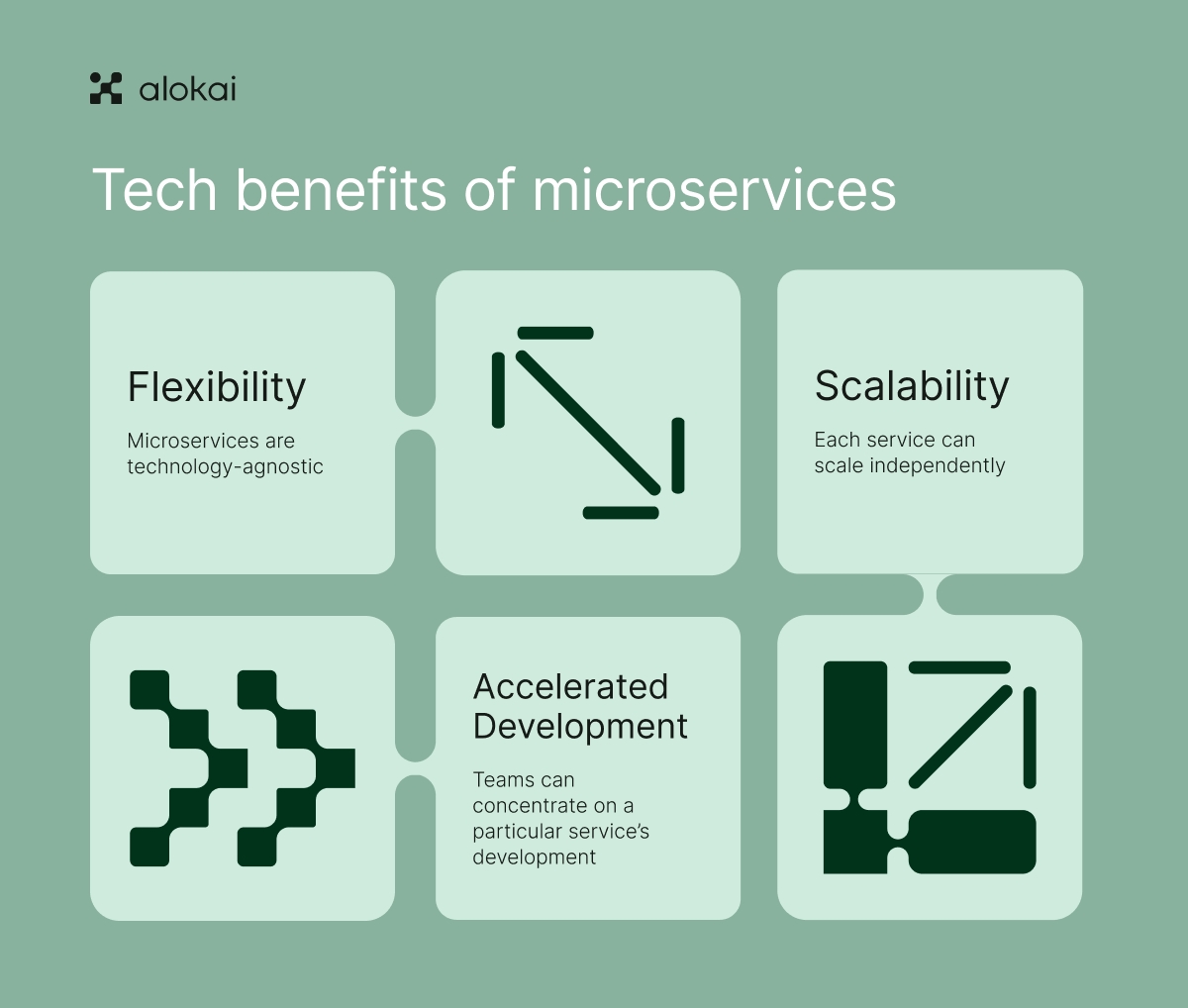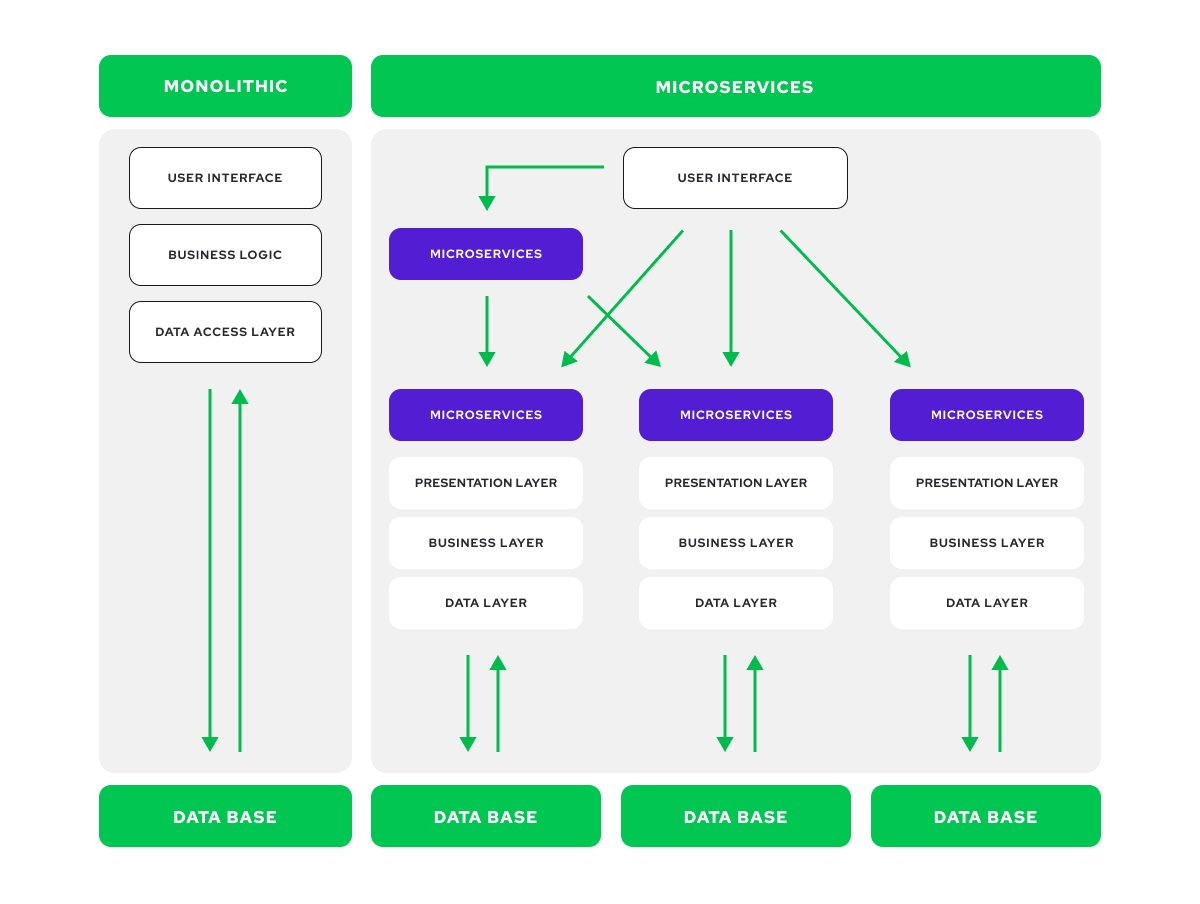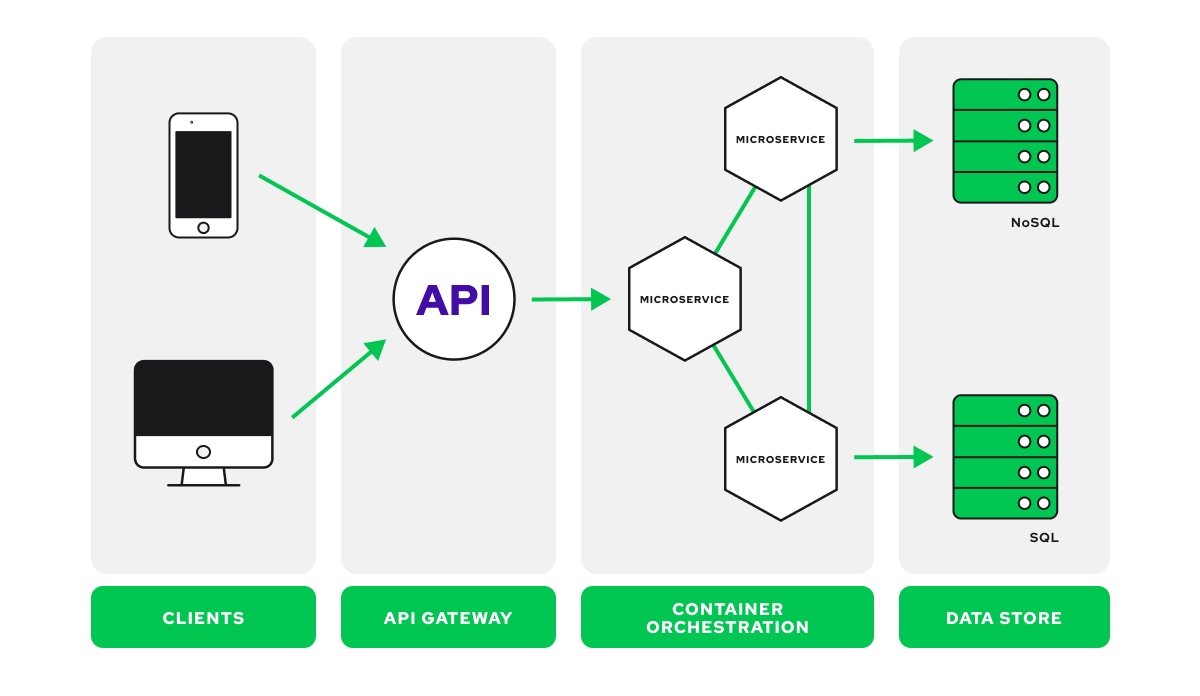Seeking the benefits of microservices? Designed for today’s dynamic tech environments, microservices provide scalability, resilience, and agility—essential components for any application in the fast-paced world of software development. Navigate through this article to understand how adopting a microservices approach can tackle specific development problems, improve your team’s efficiency, and ultimately transform your product service offerings.
Key takeaways
- Microservices architecture breaks down apps into small, independent services, boosting flexibility, scalability, and speed in delivering complex apps, much like separate teams managing different buildings in a city.
- Moving from monolithic to microservices allows businesses to adapt and scale specific parts of their applications, like expanding a city hospital during a crisis without resizing the whole town.
- Despite all their benefits, microservices come with challenges, such as increased complexity and the need for efficient communication among services. This reflects the reality that no architectural solution is without its trade-offs.
Microservices: A dive into their advantages
Picture this: a bustling city where each building, whether a restaurant, hospital, or bank, operates independently yet contributes to the city’s overall functionality. This is the essence of microservices architecture. It breaks down an application into more minor, autonomous services that run independently to form a full-fledged application. The microservices architecture offers:
- Flexibility
- Scalability
- Accelerated Development
Like our city, each microservice has a specific function, but together, they create a complete and efficient system. However, when one service fails, it can impact the overall performance.

This innovative architecture is a game-changer for modern enterprises. It improves service levels and adaptability, allowing businesses to fulfill customer demands in a rapidly evolving, technology-driven marketplace. In other words, it’s like having an individual team for each building in our city, each fostering a sense of ownership and expertise. The key benefits of microservices are numerous, but let’s dive deeper into three main advantages: flexibility in technology choices, tailored scalability, and accelerated development cycles.
Flexibility in technology choices
One of the key benefits of microservices lies in the freedom they offer. Imagine having the liberty to choose the best tools for each job. That’s the reality with microservices, as they are technology agnostic. In our city analogy, this would allow each building to choose its utilities and suppliers. This flexibility allows development teams to pick the most suitable technology stack for each service, offering adaptability and improved data security.
Being technology agnostic also means microservices can seamlessly integrate with legacy systems. It’s like upgrading parts of our city without causing disruptions to other areas. This not only provides multiple services with improved scalability, but it also allows businesses to keep up with industry trends and meet the ever-changing demands of consumers.
It’s clear that microservices offer many advantages when it comes to technology.
Tailored scalability
Scalability is key in an ever-evolving business landscape. With microservices, scaling is no longer a one-size-fits-all process. Instead, it’s a tailored approach where each service can scale independently. Returning to our city would be like scaling up the hospital during a health crisis without expanding the entire city.
Moreover, microservices architecture, a form of service oriented architecture, allows upgrades to be made to one part of the application without affecting the rest, which contributes to overall agility. This means that if a specific service experiences increased demand, resources can be allocated precisely to that service, avoiding the over-provisioning that often occurs in monolithic architectures. The result? A more efficient, cost-effective, and agile system that caters to the specific needs of each service.
Accelerated development cycles
In the race of digital transformation, speed is of the essence. The microservices architecture shines because it enables rapid software delivery. It allows developers to work on small, independent pieces of an application. Think of it as constructing buildings in our city one at a time rather than building the entire city simultaneously. This independence reduces time to market and enhances responsiveness to user needs.
Moreover, small, focused teams can concentrate on a particular service’s development, deployment, and maintenance, enhancing overall team productivity. This means faster development times and quicker deployment of new features by allowing smaller, autonomous teams to work on individual services within a microservices architecture. So, not only do microservices offer improved scalability, but they also accelerate development cycles, providing a competitive edge in the digital era.
The architectural evolution: From monolithic to microservices
Every evolution has a story, and so does the shift from monolithic architecture to microservices architecture. As businesses grow and consumer needs evolve, traditional monolithic systems can become a roadblock to innovation. Picture our city as a single, monolithic structure. Any change or upgrade to one part would require modifying the entire structure, a process as tiresome as it sounds. This is where the development process of transitioning to a microservices architecture becomes crucial.

Ecommerce platforms, in particular, have felt the pinch of monolithic systems. They’ve had to deal with cumbersome updates, the struggle to adapt to changing consumer shopping behaviors, and the demand for omnichannel experiences. Enter microservices, like a team of architects bringing a breath of fresh air, transforming the monolithic structure into a dynamic, adaptable cityscape.
The drawbacks of monolithic applications
Monolithic applications, like old-school city infrastructure, can be difficult to modify and adapt. Any change, no matter how minor, requires a complete redeployment of the entire application. It’s like shutting down the entire city to fix a pothole. This reduces agility and hampers the ability to keep up with industry trends and evolving customer needs.
Moreover, traditional monolithic architectures can lead to over-provisioning in monolithic applications, where resources are wasted because they’re allocated based on the needs of the most resource-intensive component, often demanding high processing power. Imagine if our entire city had to be supplied with the amount of electricity required for a single, high-demand building. Not very efficient, right? These drawbacks of a monolithic application pave the way for the rise of microservices.
Microservices as a response to evolving business needs
As businesses grapple with the limitations of monolithic applications, microservices offer a breath of fresh air. They allow teams to independently develop, update, and scale individual services, supporting application maintainability and testability. It’s like assigning a dedicated maintenance team to each building in our city, ensuring each one can operate and upgrade independently.
Moreover, the independent scaling and updating of microservices in a distributed system contribute to improved system resilience and better fault isolation. This means that if a single building in our city encounters a problem, it can be fixed without causing a city-wide shutdown.
In a nutshell, microservices architecture is a response to evolving business needs, providing a flexible, scalable, and resilient solution that addresses the limitations of monolithic architectures.
Microservices in action: Real-world applications

So far, we’ve explored what microservices are and the benefits they offer. But where does the rubber meet the road? How are these benefits realized in real-world applications? You’ll be surprised to learn that microservices are behind the scenes of some of the biggest players in the digital world, including Amazon, Netflix, and eBay.
These tech giants have embraced microservices to handle increased user demands, enhance performance, and deliver seamless experiences. But it’s not just about the big names. Microservices are also crucial for decentralized architectures required in big data and real-time data processing applications, as seen in e-banking and traffic control systems.
Let’s take a closer look at how ecommerce giants and streaming services are pioneering with microservices.
Ecommerce Giants: Pioneering with microservices
Ecommerce platforms have been at the forefront of the microservices revolution. By using microservices, they can add new backend functionalities independently, allowing for modular customizations and easier scalability. It’s like being able to add new features to our city’s buildings without having to remodel the entire structure.
Furthermore, microservices enable the rapid rollout of new features, updates, and bug fixes, essential for retailers to maintain a competitive edge in the fast-paced market. They allow for:
- Rapid deployment and scaling of the business to meet specific requirements
- Addressing the limitations of monolithic architectures
- Enhancing functionality and adaptability
In essence, microservices have become an integral part of ecommerce platforms.
Streaming Services: Delivering content seamlessly
Streaming services, like Netflix, are another excellent example of different services in action, particularly microservices. They leverage microservices for their ability to handle real-time data processing, ensuring instantaneous operations and delivery for a seamless user experience. Imagine our city’s movie theater can simultaneously show different films to different audiences without delay or interruption.
This capability is crucial in today’s on-demand world, where users expect instant access to content. And it’s not just about speed. Microservices enable streaming services to handle increased user demands, enhance performance, and ensure high availability, even during peak usage.
So, next time you binge-watch your favorite show, remember the power of microservices working behind the scenes!
The technical edge: Enhanced security and compliance
As we delve deeper into the world of microservices, it’s essential to consider their technical edge, specifically in terms of security and compliance. With the increasing prevalence of cyber-attacks and stringent data regulations, businesses must ensure that their systems are secure and compliant. Here’s where microservices step in.
Each microservice can implement its own security protocols, allowing businesses to protect sensitive data better and comply with GDPR and HIPAA regulations. In our city, it’s like having a dedicated security team for each building. But how exactly do microservices ensure secure communication between services and autonomous service protection? Let’s find out.
Secure communication between services
In a microservices architecture, secure communication between services is paramount. It’s like ensuring secure and private communication between the different buildings in our city. This is achieved through encryption and protocols like HTTPS and mutual TLS, which ensure that only authorized services are communicating with each other.
Moreover, cloud-native microservices provide a secure foundation for service communication, enhancing the overall resilience of cloud infrastructure against potential data breaches. In essence, secure communication in microservices is all about ensuring that each service talks only to the right services and does so securely, maintaining the integrity and privacy of data.
Autonomous service protection
In addition to secure communication, microservices also offer autonomous service protection. Each microservice can enforce authentication and apply the principle of least privilege, restricting permission levels to the minimum necessary for functionality, thus enhancing security by preventing unauthorized access.
In addition, microservices can utilize access and identity tokens such as OAuth 2.0 and OpenID Connect, implementing a standardized method for authorization across the entire system. This, coupled with the autonomous management of persistent data, reduces dependencies and increases resilience against extreme circumstances, thereby contributing to the overall protection of each service.
Streamlining operations: Microservices and DevOps
As we’ve seen, microservices offer numerous benefits, from flexibility and scalability to enhanced security. But there’s another area where they shine: streamlining operations. Here, the synergy between microservices and DevOps comes into play, bringing about a collaborative culture, which is a core aspect of DevOps and is essential for the successful management and implementation of a microservices architecture.
Microservices enable an agile approach for faster iterations and releases, allowing independent teams to embrace continuous integration and continuous delivery (CI/CD), and ship code faster. But how do they facilitate continuous integration and delivery, and how do they automate tasks and reduce overhead? Let’s dive in.
Continuous integration and delivery
Continuous integration and delivery (CI/CD) is a cornerstone of modern software development practices. Microservices architecture plays a pivotal role in facilitating CI/CD. It allows for the independent evolution and deployment of services, which is crucial for continuous integration and delivery.
Microservices accelerate software delivery by allowing development teams to work independently and integrate changes more frequently and reliably. Moreover, incorporating DevOps best practices in managing microservices includes testing, deployment, and infrastructure provisioning automation to streamline operations and reinforce continuous delivery. So, whether developing new features or pushing out updates, microservices and CI/CD go hand in hand to expedite these processes.
Automating tasks and reducing overhead
Automation is another key aspect of streamlining operations in a microservices architecture. Microservices allow for automated deployment processes, minimizing downtime and allowing for smooth transitions between application versions. It’s like having an automated city management system that keeps everything running smoothly without manual intervention. Tools such as Velero are utilized to back up and restore services on Kubernetes clusters, provide necessary redundancy, and ensure services can be quickly recovered in case of failure.
Fallback methods, such as providing default responses when a microservice fails, are critical for maintaining continuous system operation and enhancing the application's resilience. In essence, automation and reducing overhead in a microservices architecture are all about ensuring smooth, efficient, and reliable operations.
Crafting robust systems: Improved fault isolation and resilience
While microservices offer numerous benefits, they also excel in crafting robust systems with improved fault isolation and resilience. They provide fault isolation by allowing for rapid issue identification and isolating problems to prevent widespread disruption. This is akin to having a dedicated response team for each building in our city, ensuring that if a problem arises in one building, it doesn't affect the rest.
Service boundaries in microservices, acting as bulkheads, prevent the spread of failures from one service to others, reinforcing system resilience. But how do microservices ensure independent component operation and build-in redundancy? Let’s break it down.
Independent component operation
In a microservices architecture, each service operates independently, enhancing fault isolation and resilience. It’s like each building in our city functioning independently with its own utilities and services. This independence enhances fault isolation and provides the building blocks for flexible updates and technology choices.
Moreover, new components can be introduced seamlessly within the microservices architecture due to the independent operation of each service. So, if one service encounters an issue, it remains contained and does not propagate across the entire system, ensuring that critical functions remain operational. This independent operation of components is a key aspect of crafting robust systems with microservices.
Building in redundancy
Redundancy is another key aspect of crafting robust systems with microservices. In a microservices architecture, critical services can be replicated across multiple servers or nodes to ensure that if one node fails, another can immediately take over. Think of it as having backup generators for each building in our city.
The replication process in microservices involves creating multiple instances of the same service running in different environments, which requires careful coordination and management. By having redundant microservices, overall system availability is increased since users can be seamlessly routed to functioning instances without experiencing service interruption. In essence, building in redundancy is all about ensuring high availability and resilience in a microservices architecture.
Summary
We’ve journeyed through the world of microservices, exploring their key benefits, real-world applications, and even potential challenges. From flexibility in technology choices and tailored scalability to accelerated development cycles and enhanced security, microservices offer numerous benefits that revolutionize how businesses operate. And while they come with their challenges, their advantages far outweigh the downsides. So, whether you’re a tech giant or a startup, embracing microservices could be the key to unlocking agility, efficiency, and innovation.













